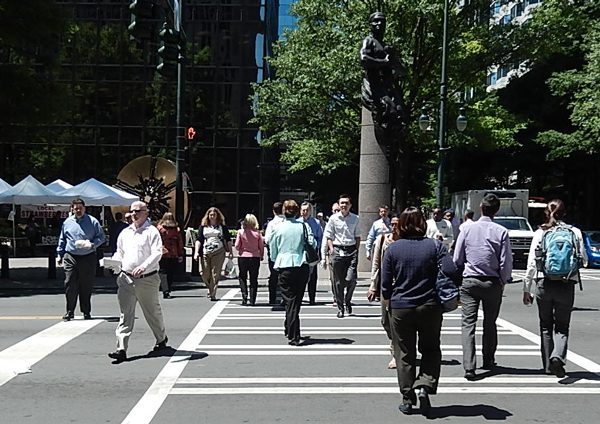As cities revive, will ‘region’ ever be sexy?

Any day now, I figure the term “inner city” will go the way of “carbon paper” and “adding machine.”
Already, it has a sort of disco, big-hair-and-shoulder-pads aura – a relic of a time when to many Americans the heart of the city was a place of poverty, crime and social dysfunction.
Compare that image to today. Surveys, marketing studies, anecdotal reports and TV shows all point to a Millennial generation in love with city life. To them, “inner city” – if used at all – would evoke excitement and opportunity.
In the ’60s and ’70s, it was a tsunami of middle-class families moving to the suburbs, hollowing out many cities, including Charlotte. Today, what’s moving to the suburbs is poverty, a demographic shift documented in studies like a recent look at congressional districts by Brookings Institution researchers, who found North Carolina’s 12th District, represented by Charlotte Democrat Mel Watt, had the nation’s largest increase suburban poverty.
Yet both images – whether derelict “inner city” or hipster downtowns – focus on the central core. That illustrates one of the biggest challenges facing U.S. cities today: the need to address the whole urban organism of city plus suburb plus exurb. Call it a commute-shed, retail trading zone or metropolitan statistical area. Whatever you call it, study after study shows that cities and their outlying areas are linked. A weak city with healthy suburbs will fail to thrive. So will a strong center city with weak suburbs.
I recently came across a passage describing mycorrhizal mushrooms. As writer Amber Veverka describes it, what you might see as a mushroom in the woods is in fact just the fruit of one vast, underground network of mycelia, white webby connectors which wind around plant roots and in doing so bring nutrients to the plant, while the plant brings water and protection to the fungus. You see the mushroom. You don’t see that it’s one unseen organism. City regions are like that. Most people don’t recognize the connections.
Last month I was lucky enough to attend a small conference, pulled together by columnist Neal Peirce, of experts in metro regions. One of the significant questions underlying the discussion was how to convey the idea that looking only at a city, or only at its suburbs, is like looking at only one leg of the elephant. Even the terms “commute-shed” and “retail trading zone” make clear that everyday lives in a metro region aren’t bound by city limits or county lines. How in the world can a region of dozens of municipalities and counties address things like transportation, protecting downtowns or preserving rural areas if all decisions are made by local governments or state governments? Local governments are, by nature, self-interested. And many state governments have historically been at best disinterested in city issues or worse, downright hostile.

Because of the U.S. governance system, commented Bill Dodge, former executive director of the National Association of Regional Councils, we depend on higher levels of government – state or federal – to sort out regional issues. But today the national government can’t make decisions, and state governments aren’t stepping into regional issues. Without state or federal attention, addressing regional issues is far more challenging. In a recent “Regional Excellence” column, he writes, “Regions have continued to grow unhealthily, and our attempts to govern them have not kept up with either the scale or the substance of the challenges.”
In the fast-growing Charlotte region, for instance, transportation and water supply threats loom large. Yet cooperation throughout the whole region on those issues is rudimentary, at best.
Dodge has some interesting ideas on the topic. One is that of voluntary regional charters, which might move into the vacuum of state and federal disinterest. His April Citiwire.net column – “A Bay Area Grand Bargain: A Model for Future Regional Governance?” – goes into detail.
But I keep coming back to Millennials, the Gen Y-ers. They are confounding many with a collective lack of enthusiasm for driving (“Is Gen Y really breaking up with the car?”) and heightened interest in bicycling, walking and transit. And while this is not statistically valid, when I’ve asked college students I meet where they want to live after college, almost all give the name of a large city or else “in a city.”
I note that they don’t say, “in a metropolitan region.”
I turned to a handy Millennial, my 21-year-old daughter. “If cities are sexy and trendy,” I asked, “why are ‘regions’ boring and dull? Or are they?” Her reply: “Cities sound like a place that you go for fun and excitement. Regions sound like something out of a textbook that details the watersheds of various rivers or something.”
I put the question out on Twitter. Raleigh city planner Ken Bowers replied: “Can you imagine a hit TV show ‘Sex and the Region’?” Michael Lewyn, who teaches law in New York and blogs for Planetizen.com, replied: “Regions sound like something invented by bureaucrats; cities seem real. Also, regions include suburbs.”
Dodge has an interesting idea. Noting that public service opportunities such as AmeriCorps, the Peace Corps, Teach For America and City Year programs don’t satisfy the demand, he proposes adding a Region Year program, “to engage the best and brightest in helping metropolitan and rural regions address the seemingly intractable challenges.”
My own hope is that the city-loving generation now coming to adulthood will, as they grow in both wisdom and wonkiness, learn that just as the old visions of the “inner city” ignored the whole unseen organism, so does today’s vision of the hipster city.
Views expressed in commentary articles here do not necessarily represent the views of the UNC Charlotte Urban Institute or the University of North Carolina at Charlotte.